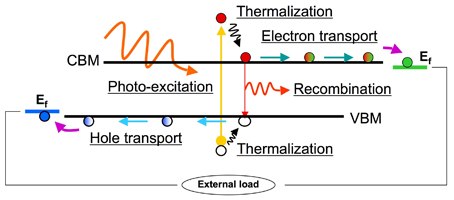The U.S. consumes roughly 100 quads (or quadrillion BTU’s) of raw energy per year. At present, about 40% of that goes towards generating electricity and the rest is essentially split between heating and transportation. Although the most abundant, sustainable source of energy is the Sun (more energy from sunlight strikes the Earth in one hour than all the energy consumed on the planet in a year), we utilize this energy powerhouse the least of all known renewable resources, with today’s consumption from solar energy at only 0.006 BTU. This means that even if the use of solar cells grows by double digits per year for decades, it will still remain a very small fraction of our total energy use. The challenge is therefore clear: we must understand and develop transformational methods to convert the single biggest renewable resource into power. Business as usual will not suffice.

In this area of research, our aim is to understand the complex interplay of electronic, structural, and optical effects that enable a material to convert sunlight into electricity efficiently. This picture shows a cartoon of the of most basic mechanisms are operative in any device that convert photons to electrons. Namely,
-
1.photo-excitation of an electron
-
2.thermalization of this excited electron/hole to conduction and valence band minima
-
3.exciton formation and diffusion
-
4.charge separation
-
5.free carrier transport
-
6.collection at metal contacts
In our work, different materials are studied with the aim of better understanding and ultimately improving one or more of these fundamental processes. Because of the range of length and time scales and the complexity of the materials under consideration, a combination of computational approaches is employed, ranging from analytic models to classical force fields, and density functional theory to more accurate many-body methods such as quantum Monte Carlo.
Below are links to descriptions of current research areas in our group involving solar cells.
Hybrid Materials for Photovoltaics
Multiband Solar Cell Materials


